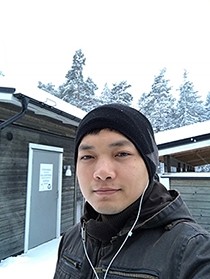New models to evaluate the inelastic dynamic response of steel structures in collision
Piseth Heng has studied solutions for vehicle collisions leading to failure of load bearing columns.
In a time where the risks of terrorist acts or extreme accidents leading to vehicles colliding into loadbearing columns of regular buildings is an increasing worry, his suggested mechanical models to prevent collapse could make a difference.

What is the topic of your Doctoral Thesis?
The failure of a load bearing column due to a vehicle collision can lead to a collapse of an entire structure or a disproportionately large part of it, called progressive collapse. In light of this problem, I have developed simple models, as an alternative solution to expensive commercial FEM programmes, to evaluate the inelastic dynamic response of steel structures collided by a rigid body.
Why did you choose this topic?
The risks of terrorist acts or extreme accidents involving a vehicle collision onto a column of a normal or a parking floor of a building is an increasing worry. The solution of using preventive barriers is not satisfactory in an architectural point of view. Therefore, a design of steel structures against impact is essentially required. However, the impact phenomenon is complex, requiring the use of expensive commercial FEM programmes. For this reason, it is useful to develop simple and accurate consistent models for this problem.
What are the most important results?
The main contribution of this thesis is the development of four simplified mechanical models that can be used to study the inelastic response of steel structure subjected to a frictionless impact. In these models, many important features are well included by adopting high-standard and well recognized theories of structural mechanics such as differential measure formulations, standard plasticity procedures, time-stepping schemes and co-rotational formulations.
Did you come across something unexpected during your thesis research?
As far as I can say, everything seems to come out as what have been planned although the development of the models and the implementation of the algorithm codes took more time than previously planned due to the complexities and the difficulties of the problems.
Who will benefit from your results?
The results of my thesis will be of most benefit to the group of practical engineers and researchers who need fast and simple tools for the process of designing structures against the impact loading, considering the assumptions and limitations of the models. The simple descriptions of the modeling of the inelastic behaviour of frame structures and the treatment of the discontinuities of velocities can also help the readers who are interested in these fields.
What will you do next?
I will be working as a research engineer at INSA de Rennes in France on other research projects relating to innovative structural beam and thermal break.
Piseth Heng defended his doctoral thesis Simplified mechanical models for the nonlinear dynamic analysis of elastoplastic steel structures impacted by a rigid body in December 2017 in the subject area Civil and Architectural Engineering with a specialisation in Structural Engineering and Bridges.

